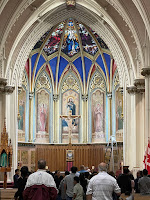Our last port of call before we got back to the states was Halifax, Nova Scotia. Halifax is capital and largest municipality in Nova Scotia, and is the largest municipality in all of the Canadian maritime provinces.
 |
| Halifax lighthouse |
 |
| Clock tower at the Citadel |
Our shore excursion options for Halifax were limited, and we ended up with an “Art and Architecture” tour (a Pam Carlson special!) that would take us to see some of Halifax’s cultural highlights. When it was time for our tour to begin, we boarded a bus and headed off for the city’s central library. Expectations were building as we got off the bus to go into the library, but these were quickly doused by locked doors and the hours-of-operation schedule indicating that the library didn’t open until noon on Sundays.
 |
| Art gallery entrance |
 |
| Maud Lewis' works |
We rode to our next stop, Citadel Hill, a Canadian National Historic Site. Founded by the English in 1749, the site was home to four different fortifications, with the last being built between 1794-1800. Referred to currently as the Halifax Citadel, it has long been the keystone to the defense of the strategically important Halifax harbor and its Royal Navy Dockyard, even though it has never been attacked.
 |
| Arctic mitten exhibit in museum |
Our next stop was the Art Gallery of Nova Scotia, a public provincial art museum established in 1908 as the Nova Scotia Museum of Fine Arts, and renamed in 1975.
 |
| Fairview Lawn Cemetery |
The museum’s permanent collection has over 18,000 works by Nova Scotia and, Canadian, and international artists and has hosted a number of traveling art exhibitions. We were given free time to explore the galleries and were drawn to the museum’s collection of works by Maud Lewis, a Canadian folk artist from Nova Scotia. Noted for her cheerful paintings of landscapes, animals, and flowers offering a nostalgic and optimistic vision of Nova Scotia, she achieved national recognition in the mid-1960s.
 |
| St. Mary's Basilica |
The museum even has her small home on display in its exhibit, the most visited exhibition space in the museum. We made our way to some other museum exhibits before our time ran out.
As we headed towards our next stop, St. Mary’s Basilica, we passed by Halifax’s Fairview Lawn Cemetery. This nondenominational cemetery is perhaps best known as the final resting place for over 100 victims of the Titanic sinking, because Halifax was one of the first communities to respond to the ship’s distress calls.
 |
| Inside St. Mary's |
 |
| Inside the library |
 |
| Library wall art |
We had a very limited amount of time in the library and there wasn’t really very much to see except books! According to Lynn, the library has won awards for its design and architecture. We went to the top floor to see the rooftop patio overlooking the city. Concluding our tour, we were taken back to our ship where we enjoyed a fresh seafood dinner, compliments of the chef’s shopping at some of Halifax’s seafood markets.

No comments:
Post a Comment